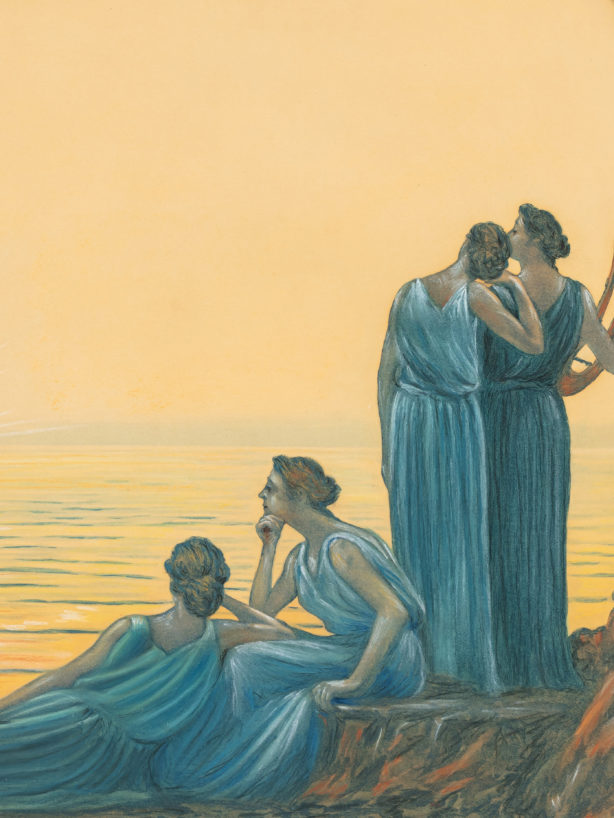Ancient evening
This pastel is a preparatory study for the large painting housed at the Petit Palais. It illustrates the full depth of Osbert’s pictorial ideal, where light and antiquity merge in poetic harmony.
The composition offers a refined vision in which female figures, dressed in antique-style garments, delicately emerge within a natural setting bathed in the soft light of dusk. These characters, imbued with quiet grace and profound serenity, seem to engage in a dialogue with their surroundings, creating a harmonious symbiosis between humanity and nature. Their presence, seamlessly integrated into the landscape with remarkable subtlety, forms the guiding thread of the work and embodies the quest for an ideal of timeless beauty, so characteristic of Alphonse Osbert’s art. The influence of Pierre Puvis de Chavannes is evident in the measured use of forms and the composition’s remarkable sobriety, lending the piece an atmosphere of calm and balance.
Osbert demonstrates particular attention to the effects of light, the result of his numerous studies en plein air, notably in the forests of Fontainebleau, where he meticulously captured the changing nuances of natural light. Moreover, his exchanges with Georges Seurat encouraged him to explore innovative chromatic approaches, without ever abandoning the classical rigor that defines the structure of his compositions. Thus, the fusion of these diverse influences enriches the work with a depth and visual subtlety that make it a perfect expression of Symbolism, blending tradition and artistic innovation.
For Osbert, painting must be a refuge, a space conducive to silent reflection. His works, bathed in soft, enveloping light, invite the viewer to serene contemplation, far from the turmoil of daily life. Through his compositions, the artist reminds us that silence is the fertile ground for deep thought, offering both the painter and the viewer a haven of peace conducive to introspection. A major figure in late 19th-century French painting, his works are housed in prestigious museums such as the Musée d’Orsay and the Petit Palais, and also adorn several public buildings, including the Church of Saint-Louis in Vichy.
***
Alphonse Osbert was born in Paris on March 23, 1857, the son of Jean-Auguste Osbert, a publisher of engravings and photographs from Normandy. His childhood was marked by a rich cultural environment, largely due to his father’s profession. In 1872, a visit to the Louvre sparked his desire to become a painter. Exempted from military service for health reasons, he was admitted in 1877 to the École des Beaux-Arts in Paris, where he studied under Henri Lehmann, a staunch defender of classicism and a former pupil of Ingres. Lehmann emphasized the importance of drawing and clear contours, which led to disagreements with Osbert, who was more drawn to color. At Lehmann’s studio, he formed friendships with Georges Seurat, Edmond Aman-Jean, and Albert Lynch.
In 1880, Osbert began his career as a painter. At this time, he was still influenced by the style of Léon Bonnat, an artist he knew personally, who gave him advice, although he was not his teacher. He was also supported by the painter Fernand Cormon, who encouraged his students to paint outdoors. Between 1887 and 1891, Osbert grew increasingly interested in nature, undertaking trips to Normandy, particularly to Diélette, where he studied the wild landscapes and waves, reminiscent of the works of Courbet and Whistler. He also experimented with pointillism, influenced by his friend Seurat. In the 1890s, Osbert became associated with the Symbolist movement, participating in events such as the Salon de la Rose+Croix, Le Barc de Boutteville, and the Salon des Cent. He formed a friendship with Joséphin Péladan, founder of the Salon de la Rose+Croix, and created Symbolist works such as Fraîcheur matinale and Mystère du soir, now housed in the Musée d’Orsay. He also held meetings at his studio at 9 rue Alain-Chartier in Vaugirard, where personalities like Alfred Jarry and Georges Seurat gathered for concerts, readings, and seances.
An important moment in the artist’s biography was his meeting with Pierre Puvis de Chavannes, whose influence deeply shaped his artistic evolution. Under Puvis’s guidance, Osbert discovered monumental decorative painting, a field that enabled him to secure prestigious public commissions, such as the frescoes at the Vichy baths (FIG. 2). His art then became resolutely decorative, difficult to classify, and imbued with a meditative atmosphere. He continued to exhibit and actively participate in the Parisian art scene until his death on August 11, 1939, in Paris.




